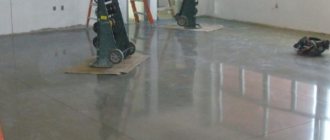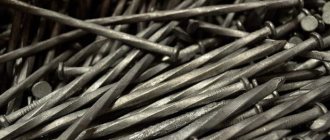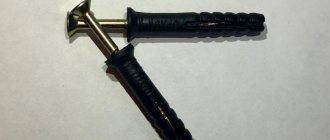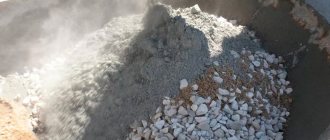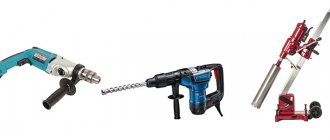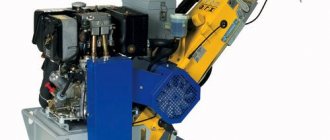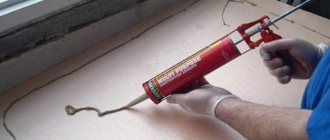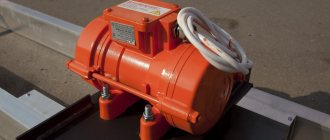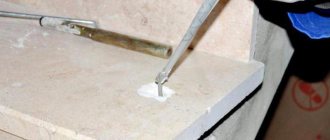Self-tapping screws for concrete and aerated concrete without drilling: photos and videos
In everyday life, there is often a need to fix something on a concrete wall. And many people perceive this as a serious problem, which is quite natural, since even self-tapping screws for concrete without drilling a mounting hole do not penetrate a monolithic surface.
However, the selection and installation of specialized fasteners is actually not as complicated a procedure as it might seem at first glance. Concrete is one of the most durable artificial building materials today, which explains the complexity of installing fasteners.
Types of self-tapping screws for concrete: photo
Step-by-step installation of fasteners without the necessary knowledge and skill can cause a lot of difficulties and problems, which cannot be ignored. There are many different types that are specially adapted for working with concrete, and each sample requires a special approach.
Dowels for concrete
The most popular tool for working with concrete surfaces are concrete screws, which are specially designed for DIY installation. They allow you to mount almost any suspended structure on concrete without much difficulty.
At the same time, the price of this product is quite affordable, compared to anchor analogues, which will cost you an order of magnitude more.
In this article, you will be provided with detailed instructions on how to use a self-tapping screw for concrete. With our help, you can choose a name to suit your circumstances and carry out the correct installation of the purchased products.
Product selection
There are several types of self-tapping screws, which differ from each other in the type of fastening, material and structure. The choice of one name or another depends on the situation and external influences that have a direct impact on the fastener. Let's look at the most common types of self-tapping screws and their scope of application.
Self-tapping screws with dowels
Self-tapping dowel for foam concrete with a plastic casing
This is the most common type of fastener on the construction market - they are produced in the form of self-tapping screws with two types of threads and plastic dowels. The presence of a dowel is explained by the fact that a hole drilled in concrete is not able to provide a tight fixation, without which the fastening will not be reliable. The plastic casing acts as a seal, which smooths out this circumstance as much as possible.
If you are selecting self-tapping screws for aerated concrete, then fastenings with dowels are the best option. Given the low density of the foam material, self-tapping screws for aerated concrete without a sealant will not be able to provide the required reliability factor.
The plastic casing increases the contact area of the self-tapping screw with the wall, which is especially important in the case of low-density concrete.
There are two types of self-tapping screws with dowels, which differ from each other in the structure of the thread.
Herringbone carving
- “Herringbone”. The herringbone profile is a non-communicating thread that is fixed in the hole using the principle of driving nails into concrete. Once fixed, such a self-tapping screw cannot be removed by unscrewing, which significantly complicates dismantling. However, they also do not need to be tightened - a few strong blows are enough, which in some cases can significantly simplify the installation process;
- Universal profile. This product looks like an ordinary self-tapping screw and is mounted accordingly. The screw is simply screwed into the dowel, and during dismantling it is removed by unscrewing. This type of fastening is somewhat inferior in reliability to the previous name.
Note! The design and shape of the dowel is determined by the manufacturer and as such, the difference in load-bearing capacity between different names is insignificant, subject to the quality of the material used.
Dowel fastening diagram
The dimensions of self-tapping screws for concrete range from 3 to 6 mm in diameter and from 12 to 220 mm in length of the product. Herringbone screws can be larger in diameter, but are somewhat limited in length.
Installation of self-tapping screws with dowels is carried out in pre-drilled holes, which must correspond to the diameter of the plastic casing. The dowel should fit tightly into the hole and not dangle. After which the fastening element itself is driven into it.
Note! The drilled hole must be deeper than the length of the supplied screw to compensate for the expansion of the shell after fixing the fastener. A few millimeters will be enough.
Self-tapping screws without dowel
Screws without dowel
Screws without a plastic seal are called “pins” - they are distinguished by variable threads, which allow the self-tapping screw to be fixed in concrete. Among non-professionals, there is an opinion that self-tapping screws are screwed into concrete without a dowel without drilling an auxiliary hole - this is erroneous. Thus, a screw can only be screwed into aerated concrete, which is not advisable, as stated above (
Requirements for the location of screws
Before installing the screws, mark the locations for their installation. Do this by following these rules:
- the distance from the edge to the first fastening point is greater than two screw lengths;
- the hole is deeper than the length of the screw;
- in bases made of porous concrete, dowels (screws) with a length of 60 mm are used, in bases made of dense concrete – from 40 mm.
- anchors are located at a distance of 120 mm from one another in cellular concrete or 150 mm in dense concrete.
- The hardware is screwed in so that cold bridges do not form between them.
How to reliably fasten a self-tapping screw in a concrete wall so that it does not fall out?
You can screw a self-tapping screw into concrete without any wood or rags. Only if the load is not large (clock, picture, shelf, etc.)
But not an ordinary self-tapping screw, but a self-tapping screw for concrete. However, it is worth noting that a self-tapping screw for high-grade concrete without pre-drilling does not exist as such. Even without the use of plastic dowels or wooden dowels, you will still have to at least just drill it first.
Next, we screw these concrete screws directly into the prepared hole.
They are called pins. One disadvantage of them is that their length usually starts from 70 millimeters and goes longer.
In this case, such a self-tapping screw for concrete will help out, the length options of which start from 35 mm.
Both of these types of screws have a diameter of 7.5 millimeters. Pre-drilling in heavy concrete (high grades) is done with a 6 mm drill.
In soft grades of concrete, you can use these self-tapping screws for concrete without drilling a hole.
They are applicable for lightweight concrete, grade M100 and lower. For example, such screws still cannot be screwed into ceiling slabs without drilling, but they are quite suitable for plastered walls. If your falling out screw was sitting in the wall, then you can screw in such a self-tapping screw along the old hole.
Unfortunately, I don’t know what role your self-tapping screw plays and what load it bears. Therefore, I will warn you that if a picture or shelf is supported on it, then a self-tapping screw for concrete can be held without a dowel. But if you are hanging a cabinet or microwave brackets, then it is better to use dowels, as the authors of the answers advise. And that’s right, the self-tapping screw is simply driven into the concrete, not for serious loads.
www.remotvet.ru
Books on the topic:
Problems of concrete technology - Robert Lhermitte - 542 rubles - link to review of the book Special concretes - Leonid Dvorkin - 528 rubles - link to review of the book Construction Technologist's Handbook - Gennady Badin - 239 rubles - link to review of the book Modern Building Materials - A Svatkov - 510 rubles - link to book review
Self-tapping screws for concrete are self-tapping screws for installing attachments, window or door frames, sheathing, insulation and finishing panels. When screwed in, the metal fastener forms an internal thread in the hole, thanks to which it is firmly held in the monolith.
Pockets are formed in the concrete body that work not for expansion, but for shear. This prevents the appearance of tearing forces in the material and the displacement of the fastening during operation.
Self-tapping screws for concrete without drilling or dowels
Each of us at least sometimes has to drill into concrete walls and other hard materials. Installation of any fastening element is carried out according to a single method: hole - cleaning the channel - fitting a sleeve (dowel, wooden "chop") - screwing in a self-tapping screw (screw). But is this always possible?
Anyone who has worked with reinforced concrete structures knows how, at the most “inopportune” moment, a drill (drill) rests on something and goes no further. It's good if it's pebbles. You can crush it with a punch and continue drilling. What if a reinforcing bar gets in the way? That's right, you need to start in a different place, moving a little, and all over again.
But when preparing a “channel” for screwing a self-tapping screw into concrete, there is another difficulty. Namely – the sleeve, its diameter. After all, the drill is selected not for the fastener itself, but for it. Can it be installed everywhere? For example, when attaching door or window blocks, it often happens that the drilling is done close to the outer surface of the wall. And the thinner the “partition” between it and the hole, the more unreliable such fixation will be.
Fastening Features
In appearance, such self-tapping screws are not much different from an ordinary screw. Although there are some specific characteristics that are determined by the purpose of the products - “for concrete without drilling”
- The material used is high-quality steel of special strength. And this is understandable, since you have to work with hard materials.
- Non-standard thread. Its configuration varies along the length of the product. Such a variable notch is called a “dowel”. It provides more reliable fixation of the self-tapping screw in concrete.
- The head is, as a rule, only with a “cross” or “asterisk”. And this is understandable, since when screwing in you will have to exert considerable effort, and ordinary slots (a slot for a flat-head screwdriver) can easily be torn off. Although there are other versions of it – turnkey hexagon, “barrel” and the like.
- Corrosion resistance. All hardware has a special coating.
- A sharp tip that easily “fits” into a dense structure (although not for all products).
- Standard diameter is 7.5 mm. And the length ranges from 50 to 200 mm.
- Reusable. This makes it possible to use such self-tapping screws for fixing temporary, removable, portable structures.
Installation method
In principle, it is the same for different concretes, the only difference is where to start.
If the material is “loose”, then it is enough to mark a point at the place where the self-tapping screw is screwed in and deepen it a little. This is easy to do with a thin cross screwdriver, an awl or something similar.
For a denser base, it is advisable to pre-drill a shallow hole to create a kind of “guide channel”. This will guarantee that the fastening element will not “lead” somewhere to the side, and it will be installed exactly perpendicular to the surface.
To securely fit the hardware, it is enough to take a 2-3 mm drill (there are some on sale for concrete). Therefore, for example, for a base made of reinforced concrete or gas silicate, the definition “without drilling” is not entirely correct. Although partially, you will still have to use a drill or hammer drill. Therefore, in such cases, it is more correct to talk about installing hardware “without a sleeve (dowel).”
Price
size table
It mainly depends on the length of the screw. If a batch is purchased (and this is usually 1,000 pieces or more), then a discount is given. Both packs (100 pcs.) and “loose” are available for sale. Retail price starts from 165 rubles/piece. But this is for products from a well-known manufacturer. Although you can often find similar fasteners for 25 rubles/piece. If a significant load on the self-tapping screw is not expected, then in principle there is no difference, and the savings are obvious.
Useful tips
When working with cellular concrete, a hole, as we have already explained, is not necessary to drill. With some effort, the self-tapping screw will “go” like this (it is recommended to use special hardware for foam concrete, for example). But in order to correctly follow the direction, it is advisable to use a special template. It's not difficult to make. A small wooden block is enough, in which a hole is made slightly larger than the diameter of the fastener, but less thick than its length.
You just need to insert a self-tapping screw into it, install it at the screwing point, then lean the template against the wall, and you can screw it in. The walls of the block will not allow the fastener to deviate from the “screwing in” axis.
In some situations, in the absence of a drill (depending on the density of the wall material), you can try to hammer the hardware like a nail. But not to the full depth, but about 1/3, otherwise its installation will not be reliable enough. And then - screw it in.
If, when drilling a channel, its diameter turns out to be slightly larger than the cross-section of the self-tapping screw (for example, a drill, the drill is “chattering”), then in order to ensure a more “deaf” fixation of the hardware, it is advisable to insert a slightly planed match into the hole together with it (the simplest option). When screwed in, the wood will be drawn into the channel and seal the existing gap.
Depending on the specifics of the work, it is necessary to select screws with a specific head. What would be more convenient to screw in - a screwdriver, a wrench, a wrench?
Such hardware is an indispensable thing when attaching attachments and on brickwork.
masterim.guru
Varieties and sizes
Screws, self-tapping screws and anchors for concrete must comply with the interstate standard “Screws” - GOST 1147-80. They differ from each other in the following characteristics:
- material type;
- coating;
- head shape and slot type;
- thread design.
Self-tapping screws are made of carbon, corrosion-resistant steel or brass. By the color of the screw you can determine the technology that was used to apply the protective coating:
- yellow or silver color for galvanized hardware - they are galvanically coated with a layer of zinc, which protects them from corrosion;
- Oxidized screws that have been in contact with oxidizing agents are black;
- gray and dark gray color for screws that have been phosphated.
The fasteners, made of brass, also have a yellow tint. Brass dowels are resistant to aggressive environments. Their disadvantage is good ductility: they are easily deformed if installed incorrectly.
Self-tapping screws for uncoated concrete are made of stainless steel and its alloys with nickel and chromium. Such hardware has high corrosion resistance.
The dowel heads can be in the shape of a cylinder, half-cone, or hexagon. They can be hidden or protruding. The types of slots in the heads and the tools required for installation of a certain type are shown in the table:
| Spline type | Tool |
| Internal cruciform | Screwdriver |
| Inner – six-pointed star | Torx key |
| External hexagonal (“barrel”) | Socket wrench |
| Internal hex | Imbus key |
Screws are made with the following types of threads:
- Cone-shaped, herringbone-shaped, which is formed by coils creeping over each other. Screw thickness – up to 8 mm, length – up to 200 mm.
- Universal. The most common type, found on self-tapping screws for various purposes. Wraps into the base both with and without a dowel. Thickness – up to 6 mm, length – up to 220 mm.
- With variable pitch of turns. It is cut on dowels, which are mounted without dowels. Along the entire length of the body of such a screw there are depressions and projections. Different thread pitch frequencies and additional notches enhance the adhesion of the hardware to brick or concrete. Diameter – 7.5 mm, length – up to 212 mm.
The table shows the dimensions, weight of thousands of pieces and other characteristics of hardware.
Self-tapping screw for concrete - what is it and what is it for?
A self-tapping screw for concrete is a type of screws made of very high quality steel. This is a rod-shaped screw on which threads are applied using an alternating method. This threading method provides maximum fixation and a high level of adhesion to the concrete wall. The self-tapping screw has a pointed, pointed shaped structure and a head for screwing in, predominantly cross-shaped. Its surface is coated with an anti-corrosion compound, which ensures long-term resistance to moisture and dampness.
This type of self-tapping screws, depending on their purpose, has different lengths, but their thickness remains unchanged. They are very convenient to use, as they involve restraining large masses without deforming. In some cases, when it is necessary to install self-tapping screws on concrete, special dowels are not required for this, but for greater reliability, experts still recommend using them. It happens that during the installation process the screws break.
To avoid traumatic consequences, you must adhere to safety rules.
Self-tapping screws for concrete without drilling
It happens when there is a need to install a self-tapping screw into a concrete wall, but there is no suitable tool for this at hand. In this case, installing self-tapping screws will be significantly more complicated, because it is quite difficult to make a hole in a concrete wall without a drill. In this case, the “folk” advice will help: you just need to hammer the self-tapping screw into the wall. But it should be borne in mind that this method is applicable only when the self-tapping screw used is intended for holding paintings or other objects of insignificant weight. For kitchen cabinets, for example, this method is not suitable, since the force of the weight will cause the screws to fall out.
In this case, it is better to get a drill and put self-tapping screws into the dowels.
How to screw a self-tapping screw into concrete
To carry out this manipulation you will need a drill or hammer drill, self-tapping screws and a regular screwdriver. To begin with, a hole is drilled in the wall to a depth equal to or slightly greater than the length of the self-tapping screw itself. The screw itself is inserted directly into the resulting hole using a screwdriver. For long-term use, it is recommended to place a small piece of a match or toothpick in the hole; in this case, the self-tapping screw will wedge tightly into the wall and not fall out. It should be noted that when screwing a self-tapping screw into concrete, it is still better to use a screwdriver than a hammer drill, since at high speeds the self-tapping screw can make the hole thicker, which can subsequently lead to its falling out. It is also necessary to pay attention to the head of the screw; if it is a Phillips head, then you need to select the appropriate screwdriver, otherwise screwing in will be delayed.
Using a self-tapping screw
So, from all of the above, it becomes clear that in order for the self-tapping screw for concrete to remain in the wall for a long time, while restraining certain loads, it is better to use a drill to install it, and attach it to the wall or on dowels (if it is intended to contain large masses), or by placing any wooden backing in the hole (suitable for shelves, pictures, etc.).
fb.ru
How to use it correctly
The dowel is used when installing PVC windows, wooden structures, aluminum profiles, door frames to concrete, brick, foam block and other walls. Before screwing in the screw, drill a hole in the brick or concrete using a special drill.
When performing this work, take into account that:
- there should be a distance of 5–6 cm from the edge (minimum);
- if PVC windows are installed, then there should be 60 cm (maximum) between the fastening points;
- if aluminum or wooden windows are installed, then the maximum distance between the fastening elements is 70 cm, and from the corner of the frame to the junction of the racks - 10 cm.
After marking the holes, they begin to screw in the dowel, while carefully securing it. If the base is made of porous or hollow material (aerated concrete, hollow block), then the fastening process is carried out without pressure, that is, only screwing movements are made. Since this design is not a so-called “capercaillie” (it is mounted together with a dowel), therefore, some precautionary measures are necessary for these actions.
Please note that a dowel with a variable thread is never combined with a dowel.
How to screw in a self-tapping screw without a dowel
Sometimes it becomes necessary to fix a dowel in the wall, but halfway it breaks. Or you don’t have the plastic part of the dowel, and finding it at the right time is problematic. In such situations, when you need to secure a self-tapping screw without a dowel, you can use a simple but effective method, which you will read about below.
To screw a self-tapping screw into a brick or concrete wall without a dowel, you need some tools. However, you don’t need anything rare or hard to find. It is necessary to prepare in advance a drill, a drill (preferably a high-quality universal one or for concrete) with a diameter slightly smaller than the self-tapping screw or screw that needs to be screwed in, and even a screwdriver.
First, mark the point where this screw or self-tapping screw should be located. Then, take a blade, cut the wallpaper at a point with intersecting lines. Bend the resulting wallpaper petals. This must be done in order not to damage the wallpaper. Subsequently, if it becomes necessary to remove the self-tapping screw, this place can be discreetly sealed again.
Next, you need to drill a hole with a thin drill, which is slightly thinner than the self-tapping screw. Try to drill efficiently and evenly. The hole must not be allowed to be larger than the required size, otherwise the self-tapping screw will not hold well in place.
Insert a match into the hole, which is best first dipped in PVA glue. Now you can screw in the screw with a screwdriver. Just don't use a screwdriver. Or use it carefully, at the lowest speeds. The fact is that if you screw in such a screw at high speeds, it will very quickly enter the wall and may spin several times, thereby destroying the walls of the hole. Accordingly, the fastening in this case will be appropriate.
Now you can hang a picture, hanging furniture and even some kind of hanging equipment on the wall. By the way, this method works best when the walls are strong enough, for example, made of high-quality brick or reinforced concrete slabs. If the wall crumbles easily, it is better to use another method.
Cut the wallpaper with a blade and bend the petals. Drill a hole slightly deeper and larger in diameter than the screw you want to screw into the wall. Cut a wooden chip according to the size of the resulting hole, which should fit tightly into the hole and not stick out from the outside. Before inserting the chop into the drilled hole, dip it in PVA. Hammer into the hole. This method is perfect for fragile walls that crumble for some reason. As a result, you will get a wooden section in the wall into which you can screw anything, and then hang what you really need on a self-tapping screw or screw.
www.zapaspro.ru
Safety precautions
Driving screws into concrete is considered a safe job, but do not be fooled into thinking that you cannot injure yourself in the process. Safety precautions must be observed as strictly as during other operations. Handling a screwdriver, drill and hammer drill requires experience and understanding of how these tools work and what their dangers are. Recommendations on how to use self-tapping screws for concrete:
- When working with a drill, it is forbidden to wear gloves, as they can get wrapped around the drill, resulting in severe injury to your hand;
- before replacing the drill, you need to let it cool by immersing it in water;
- It is necessary to drill while wearing safety glasses, otherwise a broken piece of material may get into the eye;
- when a foreign body does get under the eyelid, you need to immediately rinse the eye with plenty of water;
- if there is pain and redness in the eye, if it does not subside within a few hours, you should consult a doctor;
- when working with power tools, you need to remove children from the room and make sure that they do not enter, because the child may grab the wire and try to put the plug into the socket, get injured by a piercing or cutting edge, etc.;
- There should be no animals in the workplace area.
To avoid injury, it is not recommended to work under the influence of alcohol or drugs. Choosing the right self-tapping screw and following the operating algorithm is the key to reliable and durable fastening.
how to screw in a self-tapping screw | HEALTHY HOME
Attention!
Articles on the site for information and discussion. You need to be treated by visiting a specialist in person! An article about how to screw a self-tapping screw into a wall without using a dowel.
I invite you to the group on Subscribe.ru: Folk Wisdom, Medicine and Experience How to screw in a self-tapping screw
Every owner sometimes needs to screw a self-tapping screw into a concrete wall, but to do this, you still need to drive in a dowel, which you must try not to break, if you have one at all. But there is also a good option for screwing a self-tapping screw into a wall without using a dowel. This is exactly what will be discussed in the article.
First, let's prepare all the necessary tools. A drill, universal screws and a drill for concrete walls, as well as a Phillips screwdriver, since we will use screws with a Phillips head. Other options are also possible.
Now that everything is ready, insert the drill into the drill, and then drill a hole no less than the length of the self-tapping screw.
To be safe, you can insert a piece of toothpick or match into the hole. In this case, the self-tapping screw will sit tightly.
The next step is to screw in the self-tapping screw. At this moment you need to be very careful. You only need to use a screwdriver to screw the self-tapping screw into the wall. There is no need to do this with a screwdriver, as its rapid rotations will increase the size of the hole, which means that in the future the self-tapping screw may simply fall out.
All is ready. Now you can hang anything on a self-tapping screw without any problems. If everything is done correctly, it will withstand any load hung on it. We wish you good luck!
I advise housewives to read how to wash crystal.
If you find an error, please select a piece of text and press Ctrl+Enter.
ATTENTION:
Traditional medicine recipes are most often used in combination with conventional treatment or as an addition to traditional treatment. Any recipe is good after consultation with a specialist.
Don't self-medicate!
Share with your friends on social networks!
The site is non-profit and is being developed using the personal funds of the author and your donations. You can help!
(Even a small amount, you can enter any amount) (by card, from a cell phone, Yandex money - select the one you need)
Thank you!
Receive new articles from the site by email!
sferadoma.ru
Application
Self-tapping screws for concrete are used to attach metal, plastic, wood and concrete structures. You can hang various products on a self-tapping screw without drilling or carry out small repairs indoors using these parts to form a connection.
How to use fasteners on solid substrates
To screw concrete screws into solid foundations, a hole is drilled on the surface of the wall, the size of which is selected taking into account the parameters of the fastener. The hole size should be a few mm larger to prevent accumulation of concrete. When screwing in this fastener, it is important to ensure that the axis does not deviate. The fastener should be screwed in at low speed.
If there is no special equipment, then any drill will do, the main thing is to choose the required size and use a hammer. To do this, set the drill perpendicular to the head and gradually hammer it in with a hammer, turning the drill clockwise each time.
How to screw in a self-tapping screw without drilling
Not every builder knows how to screw a self-tapping screw into concrete without drilling. There is no need to drill a hole in walls made of expanded clay concrete or aerated concrete. Just as an additional prepared hole is not required.
For installation in such walls, screws with dowels are often used. The seal is made of cellophane, nylon and polypropylene. When the fastener is screwed in, the material begins to delaminate and comes into close contact with the wall.
Concrete screw dowel how to use
The concrete anchor screw has a ready-made metal dowel. Such self-tapping screws for hard materials are durable and durable. A simple concrete screw is also called a dowel.
The essence and types of screws for concrete
Concrete screws can withstand greater loads than conventional ones. They are made from ultra-strong hardened alloy of iron and carbon, stainless steel, brass. The pins are coated with zinc using the electroplating method. This protective layer protects the metal product from the influence of aggressive environments and corrosion. Depending on the chemical composition, the protective coating has different colors. The color of the dowel determines its functional purpose:
- silver - galvanized, suitable for various jobs in any conditions;
- yellow - coated with a layer of zinc, used for external and internal work, has a decorative function;
- black - protected with an oxidized coating, used only for interior work with moderate humidity.
All types of dowels are very durable. The flat head of such screws allows them to go deeper into the product being mounted and become invisible. The special strength of fastening of a metal product is given by its threaded uneven thread.
Nagel has found application in the installation of windows, doors, and various lightweight products made of plastic or wood, when they need to be attached to a solid base. This screw can drill through concrete, hollow and solid brick, and natural stone. Using the dowel is very easy and simple. If the fastening material will not bear a large load, then it can be screwed into the wall without a dowel. The dowel in the drilled hole will allow the screw to withstand heavy loads and prevent it from becoming loose.
Fastening wooden structures to concrete
Screw fastening
To fix the dowel in a concrete wall, it must first be drilled. To do this, use a hammer drill or a special drill for concrete. When working with durable concrete, the drill gets very hot, so it must be periodically moistened with water. The depth and diameter of the hole made must correspond to the parameters of the screw. If the drill length is not enough, the hole can be deepened with a pin. After this, the hole is thoroughly cleaned of concrete chips and a screw is screwed into the concrete through the element being mounted using a special hex or Phillips screwdriver. It is better not to use a screwdriver, because at high speeds you can easily break the brittle, hardened metal. For the same reason, do not overtighten the fastener.
If the concrete is too hard and the screw cannot be screwed into it, then it can be driven in with a hammer. But such a mount can become loose too quickly, so it can be used for mounting light objects. To attach heavy products to a drilled hole, you first need to drive a special dowel made of nylon, polyethylene or polypropylene. It will provide a strong and reliable fastening to the supporting base.
When installing the dowel, the hole must be made 5 mm larger than the plastic product. And the dowel itself should be the same size as the self-tapping screw. The plastic product should fit easily into the concrete. To speed up this process, you can lightly tap it with a hammer. After driving the dowel into the supporting base, you can screw a screw into it.
If the self-tapping screw for concrete has a herringbone notch, then it can be driven into the stone with a hammer. After this it will be impossible to unscrew it back. Metal elements with other types of cutting can be driven into a hole in concrete with a dowel already put on it. This will save time. But the calculation of the dimensions of the hole, dowel and screw must be accurate.
Herringbone screw
Its length and thickness depend on the future load on the self-tapping screw. The more mass it carries, the thicker and longer it should be. Also, for heavy objects, you need to choose screws made of strong metals and alloys. If the screw is used indoors, then its head can be painted to match the interior. They even sell ready-made self-tapping screws with decorative multi-colored heads.
Interesting screw for concrete - anchor
An anchor is a special type of fastening metal product. It consists of both a metal dowel and a bolt or stud, with a thread that is screwed into a cone-shaped nut. The base of the anchor, consisting of a hollow metal tube, has slits, and a pointed nut, when screwed into this hollow cut base, expands it. Thanks to this wedging of the tube, the anchor is firmly attached to the wall. Therefore, when using it, a regular dowel is not used.
The anchor is used only for screwing into very dense structures such as stone, concrete and brick. Unlike a dowel, a concrete screw is used for installing very heavy or bulky objects. Using such a reliable product, you can attach to a concrete base:
- heavy chandelier;
- wide suspended ceiling;
- sports equipment;
- swing;
- wooden or metal frames and boxes.
Anchor screws can be used to mount various objects. Their appearance depends on the functional purpose of metal products:
- Anchor bolt with nut - has an elongated shape. Performs 2 functions simultaneously: bolt and anchor. Used to attach several parts to a concrete base at once. With this bolt you can attach a heavy TV, corner or sheet.
- Drive-in anchor - has the appearance of a powerful metal dowel with a rough surface. Used for fastening very heavy objects to dense bases made of concrete, stone or dense brick.
- Nut and Bolt Stud Anchor - The extended knurled stud has 2 fastening ends with nuts that can be used to attach any 2 objects to a concrete base.
- Anchor hook - equipped with a special hook that allows you to hang and remove, if necessary, various stationary objects.
- Anchor Molly is a small hook designed for fastening hollow structures.
- Anchor ring - has a special curl at the end into which you can thread products and thus hang them. They are used to secure cables, chains, and hinged installations.
- Frame anchor - looks like a long thin tube with a screw inside. Suitable for attaching wooden or metal boxes and frames to a solid base.
- Spring anchor is a lightweight fastening structure. Used for fastening light, thin-walled objects. It is screwed into the base by unrolling the spring.
Anchors are expensive and are used only if a simple dowel cannot be used. Unlike other screws, anchors can withstand very heavy loads and have a wide range of uses.
Screw device
Concrete screws are made of high-strength steel, passivated with special compounds to protect against corrosion and mechanical damage when screwed in. Depending on the alloy used for passivation, self-tapping screws are available in yellow, grey, black and silver.
A screw consists of a head and a body - a metal rod with a thread. The lower part of the body of the self-tapping screw is narrowed in the form of a cone. There are notches applied to it that prevent the screws from unscrewing and falling out of the holes, and the concrete from cracking during installation.
The thread of the self-tapping screws also has notches that enhance its adhesion to concrete. The height of the thread along the body of the screw can vary. Hardware with uneven thread heights is widespread. They are suitable for working with cellular (porous) concrete, brick and similar materials.
Self-tapping screws for concrete differ from conventional screws by having a more frequent thread pitch. It allows you to use dowels without drilling holes.
